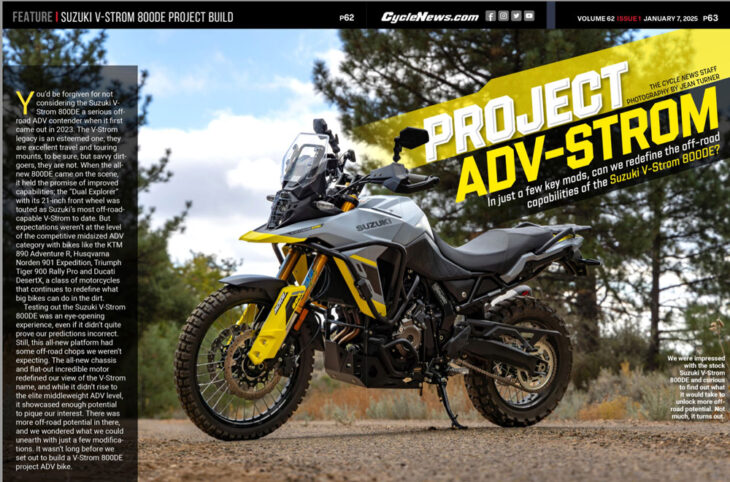Cycle News Staff | January 20, 2025
With just a few key mods, can we redefine the off-road capabilities of the Suzuki V-Strom 800DE?
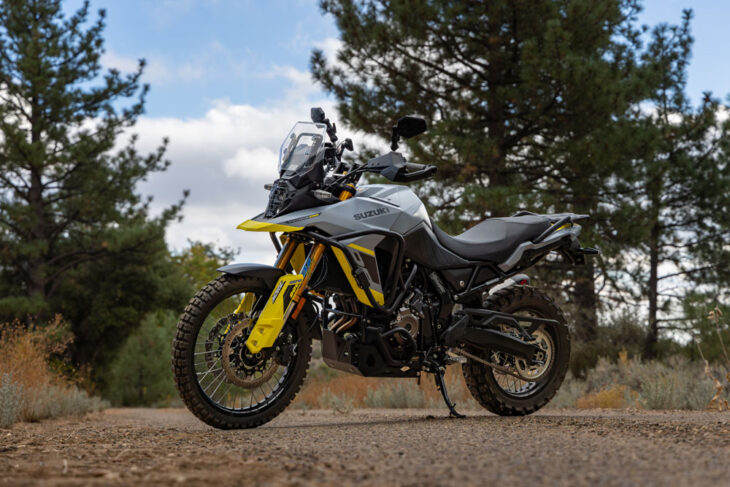 We were impressed with the stock Suzuki V-Strom 800DE and curious to find out what it would take to unlock more off-road potential. Not much, it turns out.
We were impressed with the stock Suzuki V-Strom 800DE and curious to find out what it would take to unlock more off-road potential. Not much, it turns out.
Photography by Jean Turner
You’d be forgiven for not considering the Suzuki V-Strom 800DE a serious off-road ADV contender when it first came out in 2023. The V-Strom legacy is an esteemed one; they are excellent travel and touring mounts, to be sure, but savvy dirt-goers, they are not. When the all-new 800DE came on the scene, it held the promise of improved capabilities; the “Dual Explorer” with its 21-inch front wheel was touted as Suzuki’s most off-road-capable V-Strom to date. But expectations weren’t at the level of the competitive midsized ADV category with bikes like the KTM 890 Adventure R, Husqvarna Norden 901 Expedition, Triumph Tiger 900 Rally Pro and Ducati DesertX, a class of motorcycles that continues to redefine what big bikes can do in the dirt.
Testing out the Suzuki V-Strom 800DE was an eye-opening experience, even if it didn’t quite prove our predictions incorrect. Still, this all-new platform had some off-road chops we weren’t expecting. The all-new chassis and flat-out incredible motor redefined our view of the V-Strom name, and while it didn’t rise to the elite middleweight ADV level, it showcased enough potential to pique our interest. There was more off-road potential in there, and we wondered what we could unearth with just a few modifications. It wasn’t long before we set out to build a V-Strom 800DE project ADV bike.
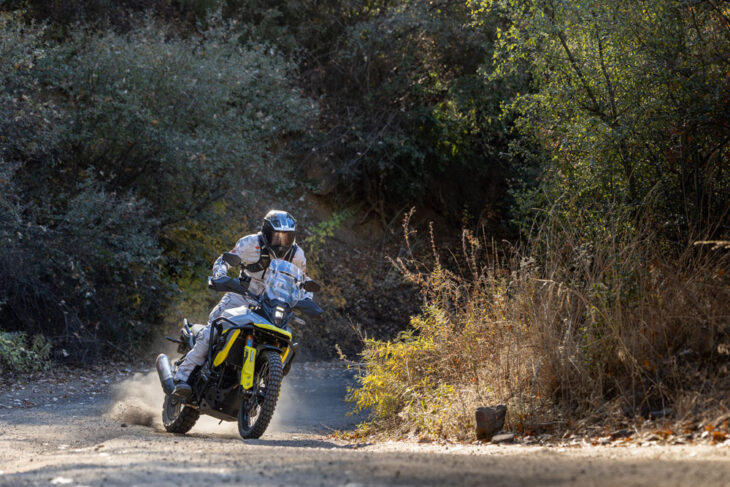 Without a lot of work or a ton of money, you can turn the V-Strom 800DE into a formidable off-roader.
Without a lot of work or a ton of money, you can turn the V-Strom 800DE into a formidable off-roader.
The goal of the project was to showcase what a “real world” build could do to improve off-road performance—no dramatic transformations to the chassis or engine. No swapping out any major components, nothing that would double the cost of the bike, and most importantly, nothing that would sacrifice its already stellar road performance. But a build of this nature is easier than it sounds. The fact that the platform (shared with the GSX-8S) is still very young, and let’s be honest, the fact that it’s a Suzuki, means that there is limited aftermarket support. You won’t find nearly the selection of ADV whizbangs for the 800DE that you’ll find for KTMs, BMWs, Triumphs and Hondas.
We had to seek far and wide for parts, we got creative with suspension tuning methods, and overcame a few curveballs along the way, but in the end, we came out with our real-world V-Strom 800DE project build that just might throw the Suzuki name into the midsized ADV conversation.
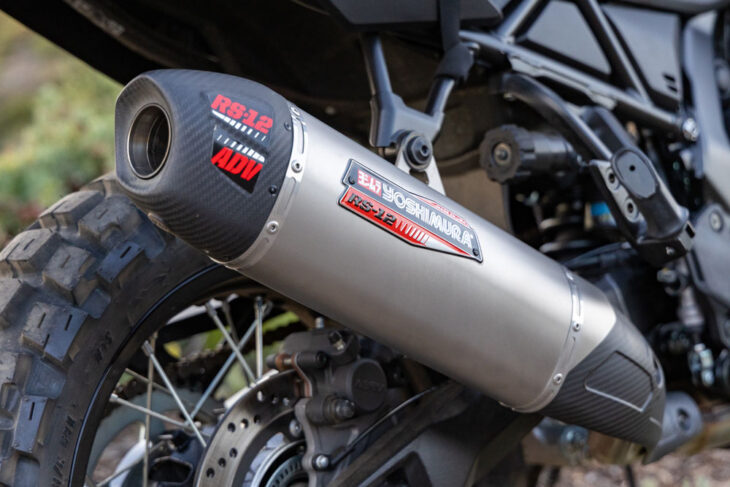 Yoshimura slip-on exhaust dropped over four pounds from the rear and livened up the engine response.
Yoshimura slip-on exhaust dropped over four pounds from the rear and livened up the engine response.
THE BUILD
We began in the obvious area—suspension. The ultra-plush stock settings give the V-Strom a very comfortable ride on the road, but even there it can be divey on the front end when riding gets sporty. In the dirt, the cushy suspension delivers a marshmallowy glide through small bumps, and hugs the ground in a way some might enjoy, but for anything approaching aggressive off-road riding, it needed a lot more hold-up, particularly from the fork. The 800DE’s 43mm Showa forks have adjustable spring preload, rebound and compression damping, but the limited range of adjustability meant we’d need to get in there for a re-valve. While it is possible to swap out the fork internals, or completely swap out the front end for a new fork, we were curious to see how much performance improvement we could find within the stock components.
TBT Racing’s Travis Flateau was our man for the job. Normally an off-road guy, “Tuner” typically specializes in motocross, GP and desert-racing-style setups. He accepted the challenge of making our V-Strom 800DE more dirt-worthy.
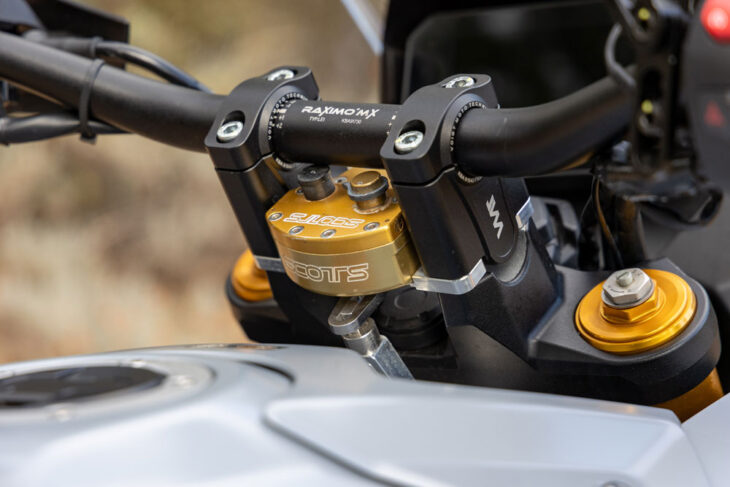 Installing the Scott’s steering damper required taller risers and a different handlebar.
Installing the Scott’s steering damper required taller risers and a different handlebar.
Spring rates in the Showa fork tubes are soft, but the springs themselves are long enough that Tuner could cut them to achieve a higher spring rate. He used a spacer to offset the length and then freshened up the valving for more aggressive performance. A TBT re-valve treatment on the shock complemented the fork, leaving us with stronger hold-up, front and rear, and a chassis with much better off-road capability and vastly improved bottoming resistance.
Pacific Powersports supplied us with its popular Motoz Tractionator Adventure tires for the Suzuki’s 21-inch front and 17-inch rear wheels. The 30/70 off-road-focused ADV tires were another immediate performance improvement, inverting the ratio from the road-going 80/20 stock tires.
The Yoshimura RS-12 slip-on exhaust was another easy add-on. The 776cc parallel-twin engine of the 800DE is pretty phenomenal on its own. There’s no real need for modifications, but the Yosh slip-on not only sharpens the throttle response and adds a really cool exhaust note, but it sheds over four pounds from the stock silencer. And it also looks super cool with the carbon-fiber heat shield.
After bumping up our performance, we focused on adding protection. A major visual and protective transformation came with the addition of crash bars and a skid plate. We had a number of options to choose from in this department and decided on SRC Moto. The upper and lower crash bars bolt up nicely with the skid plate on the 800DE for a clean look, and SRC also threw in the trick-looking headlight guard for the full setup. SRC Moto crash bars come with resin slider guards that clamp on right where the DE will (inevitably) hit the ground. Someday.
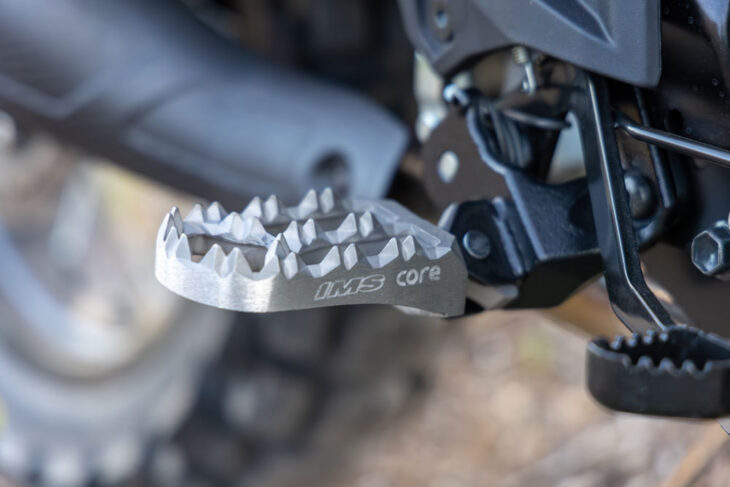 The 800DE (all Suzukis, actually) responds well to rider input, so having a positive grip on the footpegs is a big plus. We went with IMS Core Enduro footpegs.
The 800DE (all Suzukis, actually) responds well to rider input, so having a positive grip on the footpegs is a big plus. We went with IMS Core Enduro footpegs.
Doubletake mirrors were a no-brainer, as they are on just about any dual-sport or ADV bike. The Adventure Mirror Kit version 2.0 from Doubletake adds a nice touch to the cockpit. The easily adjustable mirrors can be quickly tucked away for when the going gets rough. Ergonomic improvements continued with new footpegs, and we looked to IMS for an upgrade in this area. For an adventure project, we might have opted for the ADV I or ADV II oversize pegs from IMS, but since our goal here is to up the off-road ante, we wanted something grippy, sturdy and out of the way. So, we went with the moto-style Core Enduro pegs.
From this point, we wanted to focus on tightening up the chassis, as well as adding a steering stabilizer. This is where the aftermarket got incredibly slim, and our build got more complicated.
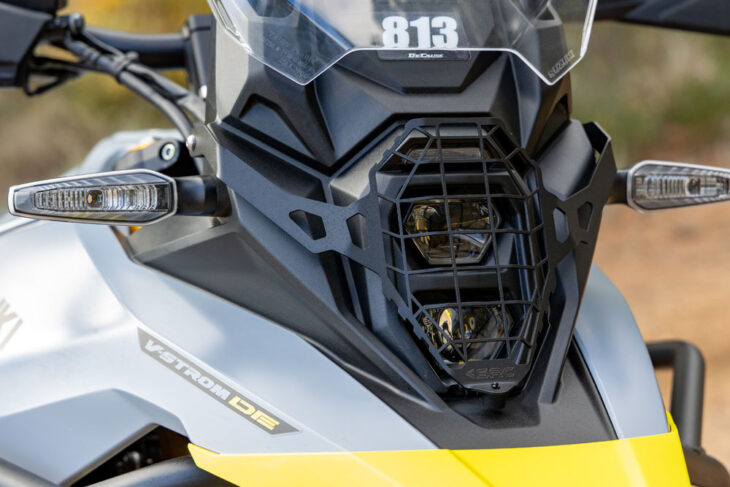 Gotta protect the glass.
Gotta protect the glass.
On the stock 800DE, the shock features a remote preload adjust knob (pretty cool), but this knob attaches to the passenger footpeg mount, meaning we can’t simply remove the passenger pegs (pretty uncool). All we would need are two bolts in order to relocate this remote knob, but you won’t find many options for this very simple mod (incredibly uncool). Fortunately, we found a solution from the Hessler Rallye Team (HRT) out of Germany. HRT has long specialized in Suzuki V-Strom off-road builds, and has come up with a number of kits and accessories for the 800DE, including this coveted bracket to relocate the preload knob. We also found a tail-tidy kit (rear fender eliminator, which HRT calls the Desert Express Rear 2.0) and Scott’s steering stabilizer mount on the HRT website. Obtaining these parts from our Deutschland friends wasn’t easy, or cheap, since HRT does not distribute in the USA. Instructions were obscure at best, and were also only in German-language YouTube videos. Completing these final steps in our build involved some inventive machine work to bridge a few gaps, but as mentioned, you’ll find a rather limited aftermarket for the mighty DE. As for a tail tidy or a mount for a Scott’s steering stabilizer, HRT is the only game in town. Or was at the time of this build.
Once installed, the tail tidy did a lot to cut weight and get rid of some bulk. The rear fender is now high and tight with the license plate tucked up away from the wheel well. Turn signals and lights still have a secure mount and function properly.
At the front, we were able to install a Scott’s steering stabilizer with a clean-looking billet mount. The sub-bar mount required running some pretty tall risers and replacing the stock handlebar with a shallower bend. Fortunately, things all evened out quite nicely with the replacement bar, and there was no need to modify the controls or cable lengths. The cockpit ergonomics remained neutral with the new moto-style handlebar, but we did quickly notice that riding the 800DE without the stock weighted bar ends was a lot less comfortable on the hands. Since part of our goal was to retain the superb road comfort, we found a way to mount the stock bar ends to the new handlebar, which also allowed us to retain the stock handguards, saving another step.
Two more creature comforts were the Peak Design phone mount with wireless charging and a clip-on windshield extender from Puig. Both of these features make life on the highway far more comfortable and are easy to stash out of the way when the pavement ends.
All told, our build set us back just under $3800.
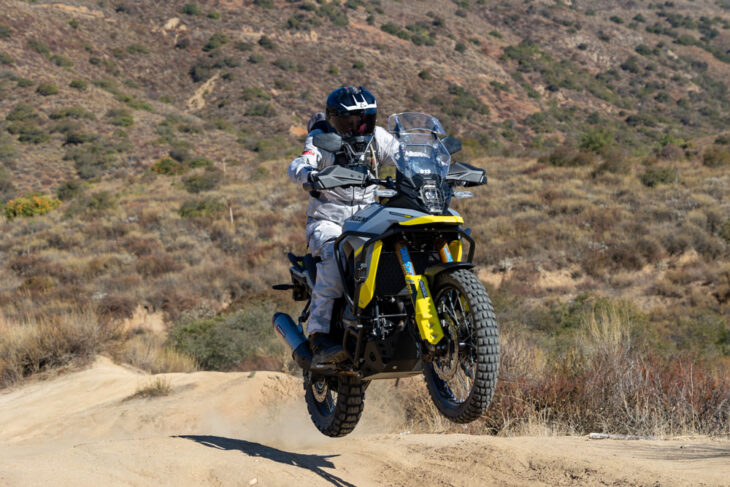 Thanks to a suspension revalve by TBT Racing, the 800DE has much better hold-up and bottoming resistance. A move like this on the stock setup would be ill-advised.
Thanks to a suspension revalve by TBT Racing, the 800DE has much better hold-up and bottoming resistance. A move like this on the stock setup would be ill-advised.
THE RIDE
We stated in our first review of the V-Strom 800DE that “with a bit of fine-tuning of the suspension, the Suzuki V-Strom 800DE would be on par with some of those other higher-cost alternatives.” As we suspected, the TBT Racing suspension and Motoz Tractionator tires transformed the V-Strom 800DE into a very fun and off-road-capable ADV bike. The mooshy feel of the suspension is gone and it now feels far more predictable in the dirt, absorbing chunky dirt and square edges with ease. The fork modifications in particular also improved the bike’s behavior on the pavement, as it is far more stable and doesn’t dive under braking.
As mentioned, we were already fans of the 776cc twin-cylinder engine and its simple (IMU-free) electronics suite, which can now really shine on the dirt as well as on the road. The Yoshimura exhaust sounds amazing, and looks just as good. Yosh claims it boosts horsepower by 1.7% and we’re not arguing. The difference we felt was a quicker-revving response and a crispier power feel at the throttle. It will keep you twisting, grinning and listening to your own sweet music as you bang through gears.
Suzuki’s traction control offers multiple levels including the new G (Gravel) mode, which is almost like cheating on loose gravel roads. It will allow the rear to step out enough to do a sweet slide, but not let the rear get away from you too easily. Add in one of the best quickshifters on the market and this ‘Zook is a blast on fast gravel roads.
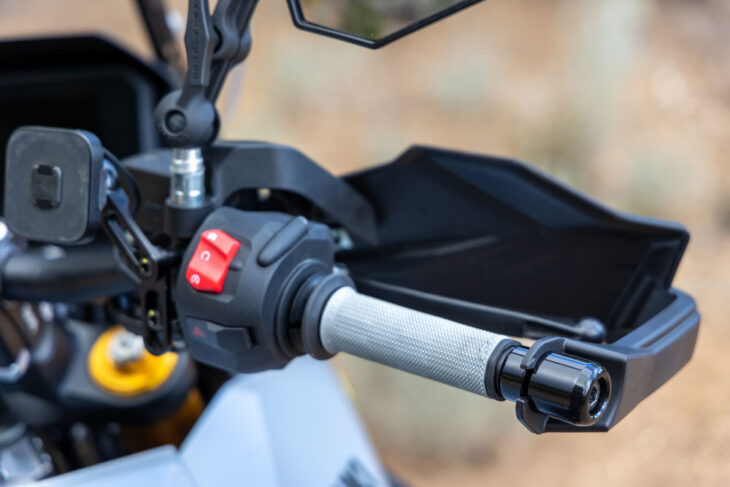 After swapping out the handlebar, we made sure to reinstall the weighted bar ends for better road comfort.
After swapping out the handlebar, we made sure to reinstall the weighted bar ends for better road comfort.
The Scott’s stabilizer is a great addition for any motorcycle that will be ridden fast in chunky terrain and is especially valuable on a 500-plus-pound ADV bike. We did manage to trim a little weight from the DE, but we didn’t tip the scales more than a few pounds. The Yoshimura RS-12 slip-on takes some weight off the back end (as does the HRT tail-tidy kit), but we came nowhere near cutting the 40-50 pounds it would take to bring it down to Yamaha Tenere 700 or Aprilia Tuareg level. She’s still a big girl.
When speeds come down, the suspension continues to improve performance. In technical terrain (fast or slow), the IMS footpegs were much appreciated, as they provide a wider, grippier stance. The 800DE already has a nice stand-over position, and we were glad to maintain the stock ergonomics while getting the steering stabilizer stashed under the handlebar. Another thing we pointed out in our initial test of the stock 800DE was the relatively lower seat height compared to other ADV bikes. While the suspension job did give a slight lift to our project bike, the stock seat still allows your feet to touch the ground, which adds confidence when the terrain gets technical.
Fortunately, we didn’t test out the SRC crash bars, but the skid plate has taken a few knocks so far, and is holding up well. The whole setup definitely looks the goods. With the HRT tail clean-up, the SRC guards, Yoshimura exhaust and Motoz tires, the V-Strom looks less like a touring motorcycle and more like a capable ADV bike.
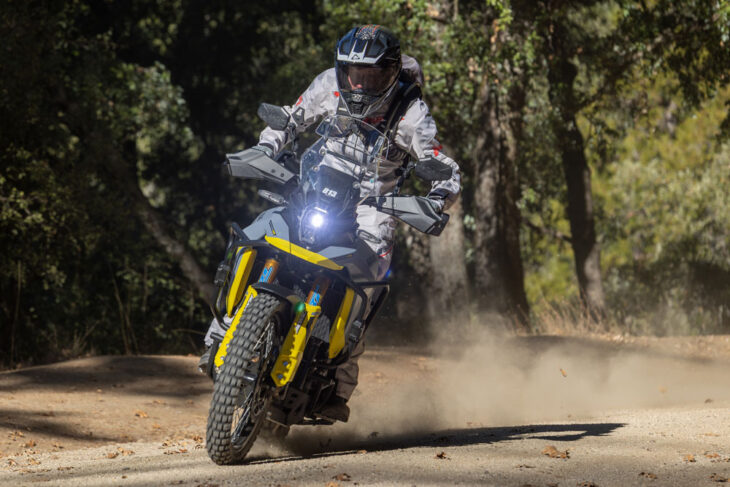 G mode on the traction-control settings is almost like cheating. It allows the rear to step out on loose gravel roads but won’t let it get out from under you.
G mode on the traction-control settings is almost like cheating. It allows the rear to step out on loose gravel roads but won’t let it get out from under you.
CONCLUSION
When it comes to the midsized ADV category, there are a lot of choices, with some that are more capable in the dirt than others. We would put the KTM 890 Adventure R and Yamaha Tenere 700 at the top of the list in terms of off-road performance, and we would not choose a stock V-Strom 800DE to go wheel-to-wheel with these bikes in the dirt. But with the modifications used on this project, this “ADV-Strom” would fit right in. While this isn’t a comparison, we can say that we accomplished our goal of upping the off-road performance threshold of the 800DE.
There are a lot of ways to throw money and parts at a bike in ways that can transform performance, but in a case like this, it’s only a handful of modifications that can draw out a bike’s potential. Suzuki has built a worthy midsized ADV contender in the V-Strom 800DE; it just needs its teeth sharpened a little to run with the pack. CN
Suzuki V-Strom 800DE Project Build Parts List
|
|
|
| Full Revalve |
$600 |
| Fork Spring Modification |
$150 |
|
|
|
| Tractionator DV Front |
$125.99 |
| Tractionator Adventure Rear |
$242.99 |
|
|
|
| RS-12 ADV Stainless Steel Slip-On |
$679 |
|
|
|
| Crash Bar Set |
$488 |
| Protective Aluminum Skid Plate |
$218 |
| Headlight Guard |
$89 |
|
|
|
| Doubletake Base Kit 3.5 Arm |
$127 |
|
|
|
| Core Enduro footpegs |
$188 |
|
|
|
| Tail Tidy (Desert Express Rear 2.0) |
95 EUR* |
| Slim Rear Kit |
88.50 EUR* |
| Steering Damper Mounting Kit |
399 EUR* |
| Holder for Hydraulic Spring Preload |
23.50 EUR* |
|
|
|
| Brake/Clutch Mount Charging |
$169.95 |
|
|
|
| Multi-Adjustable Visor 2.0 Clip-On |
$80.16 |
TOTAL:
|
$3764.11* |
*Estimated EUR-to-USD conversion
